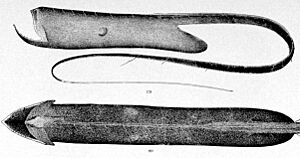Saccopharynx ampullaceus facts for kids
Quick facts for kids Saccopharynx ampullaceus |
|
|---|---|
 |
|
| Conservation status | |
| Scientific classification | |
| Synonyms | |
|
The gulper eel (also known as the taillight gulper or pelican-fish) is a fascinating deep-sea creature. It's a type of eel that lives in the ocean, mostly found in the North Atlantic Ocean. These eels can live incredibly deep, sometimes as far down as 3,000 m (9,800 ft) below the surface! Because they live so deep and are rarely seen, scientists are still learning a lot about their daily lives and where else they might be found.
Contents
What does a Gulper Eel look like?
Just like other fish in its group (called saccopharyngiforms), the gulper eel has some very unique features.
- Giant Mouth: They have a huge mouth that can open incredibly wide. This helps them catch food in the dark depths where prey might be scarce.
- Long, Thin Body: Their bodies are long and slender, almost like a whip.
- Bioluminescent Tail: The tip of their long tail has a special organ that glows! This is called Bioluminescence. Scientists aren't entirely sure why they have this glowing light, but it might be used to attract prey or even to communicate with other gulper eels.
How do they handle deep-sea pressure?
Living so deep in the ocean means dealing with immense pressure. Most fish have a gas-filled swim bladder to help them float. But the gulper eel doesn't have one! Instead, it has special spaces along its spine filled with a jelly-like substance. This substance helps the eel manage the extreme pressure of its deep-sea home. Scientists believe a special part of the eel's kidney helps maintain this unique system.
How was the Gulper Eel discovered?
The very first gulper eel specimen that scientists studied was found in a surprising way!
- A Lucky Find: In the fall of 1826, a ship called the Harmony was looking for whales in the North Atlantic.
- Mistaken Identity: The ship's captain, Captain Sawyer, spotted something floating on the surface. At first, he thought it was just an inflated seal skin.
- A Living Discovery: As they got closer, they realized it was alive! The creature was even trying to eat a fish about seven inches around.
- Studied by Scientists: This amazing 1.37 metres (4 ft 6 in) specimen was captured and preserved. It was then studied by I. Harwood, a professor of natural history, who gave it the scientific name Ophiognathus ampullaceus (which is now known as Saccopharynx ampullaceus).
Images for kids



